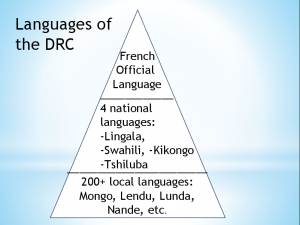The Democratic Republic of Congo, (the DR Congo or the DRC), formerly Zaïre, is characterized today by civil war and corruption. According to the BBC, the civil war has “claimed up to 6 million lives, either as a direct result of the fighting or because of disease and malnutrition,” (2017). The president, Joseph Kabila, has ruled since 2001. The following timeline presents highlights of the DR Congo’s history.
According to Weise (2017), half of the population is Roman Catholic, and over half of the population lives in rural areas. A little over 40% of the population is under the age of 15. This is due to the healthcare infrastructure, which was left without any Congolese doctors after the Congo gained its independence. Only Europeans were allowed to practice medicine. Poverty, violence, and disease are also to blame for a lower life expectancy.
The linguistic composition of the country can be summarized by the following chart:

Attribution to Raymond Sangabau, English Professor at the University of Kinshasa. Provided by Dr. Sally Cook via email correspondence 12/12/16.
Furthermore, in terms of economic conditions, which has been mentioned by some of the immigrants as a driving factor for leaving the Congo, things are also on the bleaker side. Mainly focused on natural resources (specifically minerals), the Congolese economy was heavily affected by the drop in copper prices in the 70s and the coup by Mobutu, who began to manipulate the economy to serve his personal and political goals. The civil war that broke out only worsened these problems. Since moving to a more market-based system, the economy has expanded during the past years after the end of the civil war in 2003.
The civil war still had a major effect though, especially on education, when government funding drastically declined. Though it is mandated that all children attend primary school, there is insufficient funding and not enough teachers for the country’s students. Lack of educational opportunities is another reason immigrants cited for coming to the US.
According to the Congolese Refugee Health Profile from 2014, the United Nations High Commissioner for Refugees reported more than 400,000 Congolese nationals seeking refuge outside of the DR Congo, primarily in Uganda, Rwanda, Tanzania, and Burundi from 2013 to 2014. Many Congolese refugees who are admitted to the United States come from as many as 36 African countries. The greatest number of Congolese refugees came from Tanzania (1,742). From 2008 to 2013, approximately 11,000 of the 400,000 Congolese seeking shelter came to the United States, averaging an approximate caseload of a mere 2,000 refugees a year, and the top resettlement states were Texas, Arizona, and New York.
Up next: Kirksville
References
Bavier, Joe. Congo war-driven crisis kills 45,000 a month: study, Reuters, January 28, 2008, https://www.reuters.com/article/us-congo-democratic-death/congo-war-driven-crisis-kills-45000-a-month-study-idUSL2280201220080122.
BBC Monitoring, DR Congo Country Profile, December 6, 2016, http://www.bbc.com/news/world-africa-13283212.
Kisangani, Emizet François and F. Scott Bobb, Historical Dictionary of the Democratic Republic of the (Congo UK: Scarecrow Press, 2010).
Nzongola-Ntalaja, Georges, The Congo from Leopold to Kabila (New York: Zed Books, 2002).
Quinn, John James, Global Geopolitical Power and African Political and Economic Institutions (Lanham, MD: Lexington Books, 2016).
The UN Refugee Agency, Democratic Republic of the Congo Regional Office, accessed September 24, 2017, http://reporting.unhcr.org/node/4874#_ga=2.160124213.942724404.1512688687-695233611.1512688687.
U.S. Department of Health and Human Services, Centers for Disease Control and Prevention, National Center for Emerging and Zoonotic Infectious Diseases, Congolese Refugee Health Profile, March 1, 2016, https://www.cdc.gov/immigrantrefugeehealth/pdf/congolese-health-profile.pdf.
Weise, Bernd Michael, Dennis D. Cordell, et al. “Democratic Republic of the Congo (DRC),” Encyclopædia Britannica (June 2017). Accessed September 13, 2017, Encyclopædia Britannica. https://www.britannica.com/place/Democratic-Republic-of-the-Congo/Settlement-patterns
Young, Crawford. 1994. “Zaïre: The Shattered Illusion of the Integral State.” The Journal of Modern African Studies 32, no. 2 (June): 247-63. Accessed February 24, 2016. http://www.jstor.org/stable/161769.
Slides
1- MONUSCO, Myriam A. “Aerial view of the Congo River near Kisangani, the capital of Orientale Province.” Wikimedia Commons. January 25, 2014. https://commons.wikimedia.org/wiki/File:Aerial_view_of_the_Congo_River_near_Kisangani.jpg#/media/File:Aerial_view_of_the_Congo_River_near_Kisangani.jpg
2 – Public domain. “Scramble for Africa.” Public Domain. 1885. Accessed September 2, 2017. http://www.dw.com/en/130-years-ago-carving-up-africa-in-berlin/a-18278894.
3 – Sambourne, Edward L [Public domain]. “In The Rubber Coils. Scene – The Congo ‘Free’ State.” Wikimedia Commons. November 28, 1906. https://commons.wikimedia.org/wiki/File%3APunch_congo_rubber_carton.jpg.
4 – Public domain. “William Henry Sheppard.” Wikimedia Commons. 1917. https://commons.wikimedia.org/wiki/File:WHS_portrait.jpg
5 – Holt, Lucius H. “The History of Europe from 1862 to 1914.” University of South Florida. (New York, NY: The Macmillan Company, 1918) 334 Map Credit: Courtesy the private collection of Roy Winkelman. http://etc.usf.edu/maps/
6 – World Bank. “The U.S. Secretary of the Treasury, Henry Morgenthau, Jr., addresses the delegates to the Bretton Woods Monetary Conference, July 8, 1944.” http://www.worldbank.org/en/about/archives/history/exhibits/bretton-woods-monetary-conference.
7 – Boyelo, Humprey J. L.”Université de Kinshasa, Rectorate Building.” December 26, 2006. https://commons.wikimedia.org/wiki/File%3AUniversit%C3%A9_de_Kinshasa.JPG
8 – Ganapedia. “Kwame Nkrumah – All-African People’s Conference – 1958.” January 15, 2010. https://www.youtube.com/watch?v=nHYie91wRs4
9 – British Pathé. “King Baudouin Declares Congo Independent (1960).” April 13, 2014. https://www.youtube.com/watch?v=TjCgC64odYw
10 – Public domain. “U.S. Secretary of Defense Caspar W. Weinberger meets with President Mobutu of Zaire in his Pentagon office, room 3E880.” Wikimedia Commons. August 5, 1983. https://en.wikipedia.org/wiki/Mobutu_Sese_Seko#/media/File:Mobutu.jpg
11 – AFP. “When Laurent-Desire Kabila’s Alliance rebel troops entered Kinshasa on May 17, 1997, they were hailed by the people as ‘liberators’.” May 17, 1997. Daily Mail. http://www.dailymail.co.uk/wires/afp/article-4514408/Bitter-legacy-20-years-Kinshasa-recalls-Kabila-liberation.html
12 – AFP. “Unrest in the east has forced hundreds of thousands of people from their homes.” November 2012. BBC. http://www.bbc.com/news/world-africa-11108589
13 – Tiefenthäler, Ainara, and Camilla Schick. “Violence Ripples Through Congo.” New York Times. September 22, 2016. https://www.nytimes.com/video/world/africa/100000004664378/violence-ripples-through-congo.html